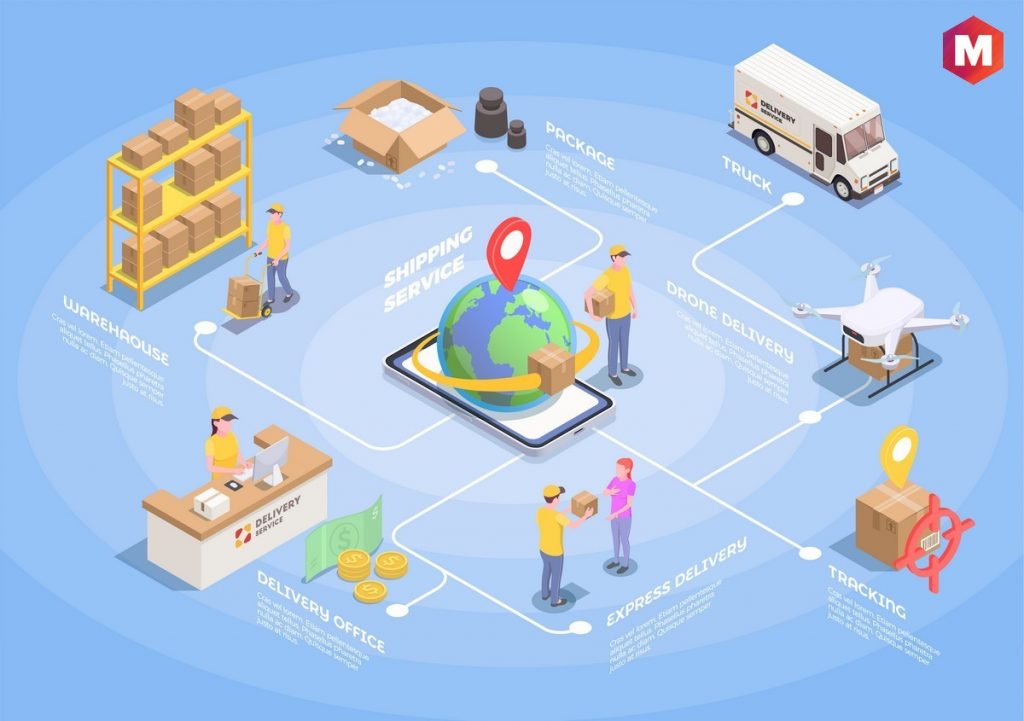Table of Contents
What is a Distribution Network?
A distribution network is a group of interconnected storage facilities and distribution methods that are used to send goods from the point of production to the point of consumption. It is an interconnected group of storage facilities and transportation systems that receive inventories of goods and then deliver them to customers. A distribution Network is an intermediate point to get products from the manufacturer to the end customer, either directly or through a retail network. A fast and reliable distribution network is essential in today’s instant gratification society of consumers.
This network can be direct, meaning that the goods go straight from the manufacturer to the consumer, or it can be indirect, which involves going through a retailer first. An efficient distribution network is vital for businesses because it allows them to get their product to the people who want to buy them, without any major delays.
A distribution network is a key part of a company’s supply chain, and it can be the difference between a successful business and one that fails. If an existing distribution network is not efficient, it can lead to products being delivered late or not at all, which can damage a company’s reputation.
A distribution network is a chain of storage facilities and transportation systems that receives goods from manufacturers and delivers them to the target customers. It’s a link (direct or via retail network) in the chain between the manufacturer and the ultimate consumer. In today’s fast-paced society of purchasers, having a quick and dependable distribution systemis critical.
Meaning of Distribution Networks
A direct distribution logistics network is a system of facilities and methods used to move goods from suppliers to customers. Logistics network design is a field of operations research that deals with the design of such networks.
Distribution networks can be designed using a variety of methods, including facility location, transportation network analysis, and capacity planning.
Distribution networks are designed to meet customer demand, which can include high levels of customer service, low transportation costs, and fast delivery. Distribution networks ensure customer satisfaction for a wider customer group including retailers, wholesalers, and manufacturers.
Distribution Networks in Supply Chain Management
The flow of items from a producer or supplier to an end consumer is referred to as a distribution network. The system includes storage facilities, warehouses, and transportation systems that enable the transport of products until they reach the end customer. Direct sales or participating in a retail network are used to guarantee that the product reaches the customer from the manufacturer.
Distribution networks range in complexity and size depending on the size of an organization or business. Large enterprises like Amazon or Apple are more likely to have sophisticated and complex distribution networks as well as transportation and logistics systems.
The most essential aspects when planning a distribution network are the product requirements of the end client, customer experience, product diversity, and product availability. Customer service is also an important element in determining the structure of a distribution network.
How to Build the Ideal Distribution Network or Model for Your Business
There are a few steps that you need to take in order to build the ideal distribution network for your business.
The first is to understand your customer base and what they want from you. You also need to understand the distribution channels that are available to you and how they can benefit your business.
Once you have this information, you can start to build a distribution network that will meet the needs of your customers and help you to grow your business.
The first step in creating an effective distribution network is to understand customer needs and how they want to receive products. Different customers have different preferences, so it’s important to cater to these needs.
Some customers may want products to be delivered to their doorsteps, while others may prefer to pick up products from a store. understanding these needs will help you to determine the best distribution channels for your business.
The second step is to understand the distribution channels that are available to you. There are many different distribution channels, and each has its own advantages and disadvantages.
You need to evaluate each distribution channel and decide which one will be the best for your business.
The third step is to create a distribution network that meets the needs of your customers and helps you to grow your business. Once you have done this, you can start to implement your distribution network and begin to see the benefits.
Real-World Examples of Distribution Network
Some of the examples of a distribution network are
1. Coca-Cola
Coca-Cola is one of the most popular beverages in the world, and it has a distribution network to match. The company has a presence in over 200 countries, and its products are available in more than 1.5 million stores.
2. Toyota
Toyota is one of the largest automakers in the world, and it has a distribution network that spans over 140 countries.
3. Walmart
Walmart is one of the largest retailers in the world, and it has a distribution network that includes more than 11,000 stores in 27 countries.
4. Nike
Nike is one of the leading sports brands in the world, and it has a distribution network that includes more than 30,000 retail stores in over 160 countries.
5. Amazon
Amazon is one of the largest online retailers in the world, and it has a distribution network that includes more than 175 million items in 10 different countries.
6. Samsung
Samsung is one of the leading electronics brands in the world, and it has a distribution network that includes more than 1,600 stores in over 70 countries.
7. Apple
Apple is one of the leading technology brands in the world, and it has a distribution network that includes more than 500 retail stores in over 30 countries.
8. Sony
Sony is one of the leading entertainment brands in the world, and it has a distribution network that includes more than 2,000 stores in over 100 countries.
9. Microsoft
Microsoft is one of the leading software companies in the world, and it has a distribution network that includes more than 5,000 retail stores in over 40 countries.
10. Google
Google is one of the leading Internet companies in the world, and it has a distribution network that includes more than 1 billion devices in over 160 countries.
These are some of the most popular distribution networks in the world. As you can see, each company has a different distribution network based on its needs. You should evaluate your distribution needs and create a distribution network that meets the needs of your customers and helps you to grow your business.
Benefits of Deciding on a Distribution Network
There are several benefits of creating a distribution network, including-
1. Reach
A distribution network gives you the ability to reach a larger number of customers.
2. Efficiency
A distribution network can help you to be more efficient in your distribution process.
3. Cost
A distribution network can help you to save money on distribution costs.
4. Scale
A distribution network can help you to scale your business more easily.
5. Growth
A distribution network can help you to grow your business more effectively.
6. Branding
A distribution network can help you to build a stronger brand.
7. Customer Loyalty
A distribution network can help you to create more customer loyalty.
8. Competitive Advantage
A distribution network can give you a competitive advantage in your industry.
9. Expansion
A distribution network can help you to expand your business into new markets.
10. Diversification
A distribution network can help you to diversify your product line.
Creating a distribution network can be a complex process, but it is an important part of growing your business.
You should carefully evaluate your distribution needs and create a distribution network that meets the needs of your customers and helps you to grow your business.
How to choose the right Distribution Network for your Business?
Creating a distribution network is a complex process, but it is an important part of growing your business. You should carefully evaluate your distribution needs and create a distribution network that meets the needs of your customers and helps you to grow your business. Here are some tips to help you choose the right distribution network for your business:
1. Define your distribution goals
The first step is to define your distribution goals. What do you want to achieve with your distribution network? Do you want to reach a larger number of customers? Do you want to be more efficient in your distribution process? Do you want to save money on distribution costs? Once you have defined your distribution goals, you can start to create a distribution network that meets your needs.
2. Evaluate your distribution options
There are many different distribution options available, and you need to evaluate which option is best for your business. You should consider the cost of distribution, the efficiency of distribution, and the reach of distribution when evaluating your options.
3. Choose the right distribution partners
Once you have evaluated your distribution options, you need to choose the right distribution partners. You should consider the size of the distribution partner, the reach of the distribution partner, and the reputation of the distribution partner when choosing a distribution partner.
4. Negotiate distribution agreements
Once you have chosen your distribution partners, you need to negotiate distribution agreements. You should consider the terms of the distribution agreement, the distribution partner’s obligations, and your own obligations when negotiating a distribution agreement.
5. Create a distribution plan
After you have negotiated your distribution agreements, you need to create a distribution plan. The distribution plan should include the distribution partners, the distribution channels, the distribution methods, and the distribution schedule.
6. Implement your distribution plan
Once you have created your distribution plan, you need to implement your distribution plan. You should carefully select the distribution partners, the distribution channels, and the distribution methods that you will use to reach your goals.
7. Monitor your distribution network
After you have implemented your distribution plan, you need to monitor your distribution network. You should monitor the performance of your distribution partners, the distribution channels, and the distribution methods to ensure that your distribution network is performing as planned.
8. Modify your distribution network
As your business grows, you may need to modify your distribution network. You should regularly evaluate your distribution network to ensure that it is meeting your distribution goals.
Conclusion!
On the concluding note, it is clear that a distribution network is a very important step in the process of business growth. A distribution network allows you to reach a larger number of customers and to be more efficient in your distribution process.
It is important to carefully evaluate your distribution needs and to choose the right distribution partners. You should also negotiate distribution agreements and create a distribution plan.
Finally, you should monitor your distribution network and make changes as needed. following these tips will help you create a distribution network that meets your needs and helps you to grow your business.
How effective do you think a distribution network is for business growth? Let us know in the comments below!
Liked this post? Check out the complete series on Distribution


I want to be a stockist, from Maseru Lesotho